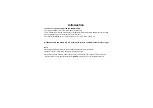
In the example above, if a hearing aid meets the M2 level rating and the wireless phone meets the M3
level rating, the sum of the two values equal M5. This should provide the hearing aid user with “normal
usage” while using their hearing aid with the particular wireless phone. “Normal usage” in this context
is defined as a signal quality that’s acceptable for normal operation.
The M mark is intended to be synonymous with the U mark. The T mark is intended to be synonymous
with the UT mark. The M and T marks are recommended by the Alliance for Telecommunications
Industries Solutions (ATIS). The U and UT marks are referenced in Section 20.19 of the FCC Rules. The
HAC rating and measurement procedure are described in the American National Standards Institute
(ANSI) C63.19 standard.
When you’re talking on a cell phone, it’s recommended that you turn the BT (Bluetooth) or WLAN
mode off for HAC.
For information about hearing aids and digital wireless phones
Wireless Phones and Hearing Aid Accessibility
http://www.accesswireless.org/
Gallaudet University, RERC
http://tap.gallaudet.edu/Voice/
FCC Hearing Aid Compatibility and Volume Control
http://www.fcc.gov/cgb/dro/hearing.html
The Hearing Aid Compatibility FCC Order
http://hraunfoss.fcc.gov/edocs_public/attachmatch/FCC-03-168A1.pdf
Hearing Loss Association of America [HLAA]
http://hearingloss.org/content/telephonesand-mobile-devices
Part 15.105 statement
This equipment has been tested and found to comply with the limits for a class B digital device,
pursuant to Part 15 of the FCC rules. These limits are designed to provide reasonable protection against
harmful interference in a residential installation. This equipment generates, uses, and can radiate radio
M3 + M2 = 5
T3 + T2 = 5
frequency energy and, if not installed and used in accordance with the instructions, may cause harmful
interference to radio communications. However, there is no guarantee that interference will not occur
in a particular installation. If this equipment does cause harmful interference or television reception,
which can be determined by turning the equipment off and on, the user is encouraged to try to correct
the interference by one or more of the following measures:
• Reorient or relocate the receiving antenna.
• Increase the separation between the equipment and receiver.
• Connect the equipment into an outlet on a circuit different from that to which the receiver is connected.
• Consult the dealer or an experienced radio/ TV technician for help.
*Service not available everywhere.
*Information subject to change.
Part 15.21 statement
Changes or modifications that are not expressly approved by the manufacturer could void the user’s
authority to operate the equipment.
Battery information and care
Always unplug the charger from the wall socket after the phone is fully charged to save unnecessary
power consumption of the charger.
• To reduce risk of fire or burns, do not expose to temperature above 60°C (140°F), or dispose of in fire.
• To reduce risk of fire or burns, do not dispose of in fire or water.
• Do not disassemble or open crush, bend or deform, puncture or shred.
• There is a danger of explosion if battery is incorrectly replaced. To reduce risk of fire or burns, do
not disassemble, crush, puncture, short external contacts, expose to temperature above 60°C (140°F),
or dispose of in fire or water. Keep this product away from excessive moisture and extreme
temperatures. Keep the battery or device dry and away from water or any liquid as it may cause a
short circuit.
• Avoid using your phone near strong electromagnetic sources, such as microwave ovens, sound
speakers, TV and radio.
• Use only original manufacturer-approved accessories, or accessories that do not contain any metal.
Please only use an approved charging accessory to charge your LG phone. Improper handling of the
Accessory/Charger Port, as well as the use of an incompatible charger, may cause damage to your
phone and void the warranty.
• Only use the approved battery charger. Otherwise, you may cause serious damage to your phone.
Danger of explosion if battery is incorrectly replaced. To reduce risk of fire or burns,
• Do not disassemble, crush, puncture, short external contacts
• Do not expose to temperature above 60°C (140°F), or dispose of in fire or water.
• Replace only with specified batteries.
• Recycle or dispose of used batteries according to the local regulations or reference guide supplied
with your product.
• Do not allow the leaking fluid to come in contact with skin or clothing. If contact occurs, flush the
affected area immediately with clean water and seek medical advice.
• Do not allow the leaking fluid to come in contact with eyes. If contact occurs, DO NOT rub; rinse with
clean water immediately and seek medical advice.
• Take extra precautions to keep a leaking battery away from fire as there is a danger of ignition
or explosion.


































